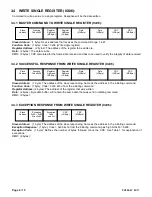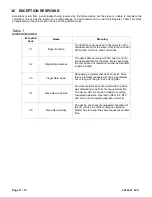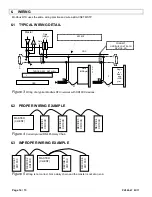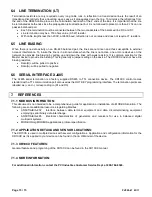
Page 15 / 15
PV500-67 03/17
6.4 LINE TERMINATION (LT)
Termination resistors are only required on very long cable runs. A reflection in a transmission line is the result of an
impedance discontinuity that a travelling wave sees as it propagates down the line. To minimize the reflections from
the end of the RS485-cable, place a Line Termination near each of the 2 ends of the Bus. It is important that the line
be terminated at both ends since the propagation is bi-directional, but it is not allowed to place more than 2 LTs on one
passive balanced pair.
Each line termination must be connected between the two conductors of the balanced line: D0 and D1.
Line termination may be a 150 ohms value (0.5 W) resistor.
With cable lengths less than 2000’, at 9600 baud, reflection is not an issue and does not require LT resistors.
6.5 LINE BIASING
When there is no data activity on an RS-485 balanced pair, the lines are not driven and thus susceptible to external
noise or interference. To insure the line is in a known state when the line is not active, one or more devices on the
network can provide line biasing by pulling up and down the lines with week resistors. It is common practice for the
Master device to provide line biasing. This is generally a jumper setting on the device. The XR10CX does not have line
biasing resistors.
Data(B)+ will be pulled to positive
Data(A)- will be pulled to negative
6.6 SERIAL INTERFACE XJ485
The XJ485 serial termination is a factory supplied RS485 to TTL connection device. The XR10CX control comes
standard with a TTL communication port also used as the HOT KEY programming interface. The termination points are
labelled as (+ and
–) corresponding to (D1 and D0).
7. REFERENCES
7.1.1 MODBUS INFORMATION:
This document is not intended to be a comprehensive guide for application or installation of a MODBUS solution. The
following are some additional resources regarding Modbus:
ANSI/TIA/EIA-232
Interface between data terminal equipment and data circuit-terminating equipment
employing serial binary data interchange.
ANSI/TIA/EIA-485
Electrical characteristics of generators and receivers for use in balanced digital
multipoint systems.
MODBUS.org MODBUS applications protocol specification.
7.1.2 APPLICATION DETAILS AND SENSOR LOCATIONS:
The XR10CX is used in multiple devices with several configurations. Application and configuration information for the
XR10CX as it is applied to your device can be found in the I & O Manual of the device.
7.1.3 XR10CX FEATURES:
General features and programing of the XR10CX can be found in the XR10CX manual.
7.1.4 MORE INFORMATION:
For additional information, contact the PVI Industries Customer Service Dept. at 800-784-8326.

































